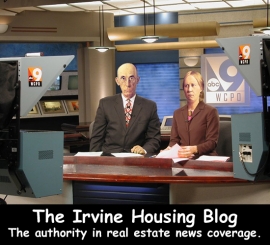To give the hopeless a reason not to strategically default, several banks have singled out a few deeply underwater loan owners for principal forgiveness. By spreading news of their magnanimous deeds, they hope the remainder will keep paying.


Irvine Home Address … 37 LONG Mdw #15 Irvine, CA 92620
Resale Home Price …… $374,900

There are secrets that we still have left to find
There have been mysteries from the beginning of time
There are answers we're not wise enough to see
Five For Fighting — The Riddle
Banks have a problem, a riddle they must solve. Twenty-five percent of their borrowers are underwater, and when you factor in second mortgages and sales commissions, more than half can't sell their homes without writing a check for the shortfall. And house prices are still going down. When homeowners have no equity, they are no longer homeowners, they are loan owners. If a loan owner's payments are less than the cost of a comparable rental, they have an incentive to stay and pay, but when the payment exceeds a comparable rental — and the huge mortgage balances of the bubble make this common — loan owners have an incentive to keep their money and strategically default on their mortgage.
Underwater loan owners have their names on title, and if they keep making payments long enough, amortization may catch them up, and prices may come back, so they may have equity again someday. The more their payments exceed the cost of rental, the further a loan owner is underwater, and the longer they perceive they will have to wait to have equity again, the more likely they are to give up and strategically default. If a loan owner strategically defaults, the lender is forced to make a choice; foreclose on the property when the resale value is worth less than the loan, or allow the loan owner to squat in the property. Neither choice is palatable to the lender.
Lenders have responded to these circumstances — conditions the lenders created through irresponsible lending which inflated the housing bubble — by using both a carrot and a stick to keep borrowers paying when it is in the best interest of the borrower to strategically default. The stick is the threat of foreclosure, debt collection, reduced access to credit in the future, and an appeal to morality. The specter of consequences to borrowers has been wildly exaggerated, and these circumstances are lessening by the day. The appeal to morality has been steadily eroding as borrowers are coming to realize they have a greater moral responsibility to their families than they have to their lenders.
Lenders threats of foreclosure have been neutralized by reports of delinquent mortgage squatters obtaining years of free rent. In fact, instead of being a deterrent to strategic default, the long foreclosure timelines have actually become an inducement. Lenders combat this perception with the use of terrorist tactics. Each month, lenders will randomly select a small number of fresh delinquencies to push through the system as quickly as possible. If some of the herd are executed quickly while others are allowed to squat indefinitely, it creates uncertainty. This uncertainty keeps some paying rather than play Russian roulette.
The carrot lenders dangle in front of loan owners comes through rumors of principal reduction windfalls. Like the random executions of freshly delinquent borrowers, a very small number of principal reductions given to loan owners who are doing what lenders want — making all payments — provides the lottery-style false hope to motivate the masses. Today's featured article is part of the public relations campaign lenders use to get the word out concerning the principal reduction lottery windfall ostensibly available to loan owners who dutifully make their payments.
If someone somewhere got a principal reduction, it could happen to anyone. I hope nobody is holding their breath.
Big Banks Easing Terms on Loans Deemed as Risks
By DAVID STREITFELD
Published: July 2, 2011
As millions of Americans struggle in foreclosure with little hope of relief, big banks are going to borrowers who are not even in default and cutting their debt or easing the mortgage terms, sometimes with no questions asked.
The ultimate debtors fantasy: money for nothing.
Two of the nation’s biggest lenders, JPMorgan Chase and Bank of America, are quietly modifying loans for tens of thousands of borrowers who have not asked for help but whom the banks deem to be at special risk.
Rula Giosmas is one of the beneficiaries. Last year she received a letter from Chase saying it was cutting in half the amount she owed on her condominium.
Ms. Giosmas, who lives in Miami, was not in default on her $300,000 loan. She did not understand why she would receive this gift — although she wasted no time in taking it.
Ms. Giosmas received the gift because Chase probably recognized she was one of the last who didn't strategically default, and based on their analysis, there was a very high probability of her doing so in the future. The likely reduced her balance to a level that reduced their loss from what it would have been if Chase had to foreclose and resell another REO. Plus, they could then get this story written.
Banks are proactively overhauling loans for borrowers like Ms. Giosmas who have so-called pay option adjustable rate mortgages, which were popular in the wild late stages of the housing boom but which banks now view as potentially troublesome.

Before Chase shaved $150,000 off her mortgage, Ms. Giosmas owed much more on her place than it was worth. It was a fate she shared with a quarter of all homeowners with mortgages across the nation. Being underwater, as it is called, can prevent these owners from moving and taking new jobs, and places the households at greater risk of foreclosure.
“It’s a huge problem,” said the economist Sam Khater. “Reducing negative equity would spark a housing recovery.”
Giving away free money will not spark a housing recovery. It would however reward those who overborrowed under stupid terms which would encourage imprudent borrowing again in the future.
While many homeowners desperately need help to keep their homes and cannot get it, the borrowers getting unsolicited relief from Chase sometimes suspect a trick. Cutting loan balances, even for loans in default, is supposedly so rare that Federal Reserve economists wrote in a paper in March that “we could find no evidence that any lender was actually reducing principal” on mortgages.
Principal forgiveness is rare because it is really stupid. Rumors of principal reduction have been used by lenders in the past to get borrowers to contact them to try to work out loan modifications, but lenders don't want to start reducing principal because all of their customers would ask for it. Besides, foreclosure is a superior form of principal reduction because the borrower has consequences for their foolish borrowing.
“I used to say every day, ‘Why doesn’t anyone get rewarded for doing the right thing and paying their bills on time?’ ” said Ms. Giosmas, who is an acupuncturist and real estate investor. “And I got rewarded.”
No, Ms. Giosmas got rewarded for taking out a very foolish loan at the worst possible time. It encourages the worst form of borrower stupidity. Lenders are happy to have this framed as a reward for making payments on time in hopes that others will do the same. They couldn't have scripted her comments any better.
Option ARM loans like Ms. Giosmas’s gave borrowers the option of skipping the principal payment and some of the interest payment for an introductory period of several years. The unpaid balances would be added to the body of the loan.
Bank of America and Chase inherited their portfolios of option ARMs when they bought troubled lenders during the housing crash.
Chase, which declined to comment on its program, got $50 billion in option ARM loans when it bought Washington Mutual in 2008. The lender, which said last fall that it had dealt with 22,000 option ARM loans with an unpaid principal balance of $8 billion, still has $33 billion of them in its portfolio.
I foresee some major write-downs still to come.
Bank of America acquired a portfolio of 550,000 option ARMs from its purchase of Countrywide Financial in 2008. The lender said more than 200,000 had been converted to more stable mortgages.
Dan B. Frahm, a spokesman for Bank of America, said it was using every technique short of principal reduction to remake its loans, including waiving prepayment penalties, refinancing, lowering the interest rate, postponing some of the balance and extending the term.
“By proactively contacting pay option ARM customers and discussing other products with better options for long-term, affordable payments, we hope to prevent customers from reaching a point where they struggle to make their payments,” Mr. Frahm said.
Chase, Bank of America and the other big lenders are negotiating with the Obama administration and the nation’s attorneys general over foreclosures. Debt forgiveness and the moral hazard question of who deserves to be helped are among the most contentious issues.
These news stories make moral hazard sound like some minor inconvenience when it is the core of the problem. If you give away money, it isn't a loan anymore, it is welfare going to the least deserving.
The banks say cutting mortgage balances would be unfair to borrowers who remain current as well as impractical because so many loans are securitized into pools owned by investors. Bank of America’s chief executive, Brian T. Moynihan, told the attorneys general in April that cutting principal for current borrowers would send the wrong message to all those who have struggled to pay their bills. His counterpart at Chase, Jamie Dimon, bluntly said it was “off the table.”
Good. It should be off the table. Foreclosure and bankruptcy are viable alternatives which provide consequences to the borrower for their behavior. Without consequences, no borrower would exercise any judgment or self control when considering a loan. Loans become free money for the taking.
Having an option ARM loan, however, apparently qualifies the borrower for special help. The loans, with their low initial payments and “teaser” interest rates, were immediately popular with buyers who could not afford or did not want to pay the soaring prices on houses. The problem was, eventually the rate would reset or the loan balance would have to be paid in full. “Nightmare Mortgages” they were called in a 2006 BusinessWeek cover piece.
Option ARMs were never quite as bad as predicted, partly because the crisis pushed down interest rates so far that the resets were relatively mild. Many owners did default on them, but others, like Ms. Giosmas, were quite happy to pay less for years than they would have under a conventional loan. She used option ARMs on her investment properties too.
“They saved me,” she said. “Why would I want to pay a lot more every month? I’d rather have it in my pocket.”
Does anyone else see the insanity being encouraged here? This woman believed she was making a wise financial decision using an Option ARM, and the bank is reinforcing this belief by giving her a principal reduction. Borrowers incentives should be to pay down debt to reduce risk for both the lender and the borrower. If borrowers have the mindset to maximize their debt and minimize their payments, that's how Ponzi schemes are born. Our housing market will never find stability under those terms.
The concern the banks are showing for those who might get in trouble contrasts sharply with their efforts toward those already foreclosed. Bank of America and Chase were penalized last month by regulators for doing a poor job modifying mortgages in default.
Adam J. Levitin, a Georgetown University law professor, said these little-publicized programs were more evidence that the banks were behaving in contradictory and often maddening ways.
“Loan modifications that should be happening aren’t, while loan modifications that shouldn’t be happening are,” he said. “Homeowners of any sort, whether current or in default, would rightly be confused and angry by this.”
Borrowers who borrowed prudently and make their loan payments should be the most outraged by principal reductions. They aren't getting any free money from the banks; however, their foolish neighbors who borrowed irresponsibly are obtaining windfalls.
The homeowners getting new loans, however, are quite pleased. In effect, the banks are paying the debt these owners accrued as the housing market plunged.
Ms. Giosmas bought her two-bedroom, two-bath apartment north of downtown Miami for $359,000 in early 2006, according to real estate records. She made a large down payment, but because each month she paid less than was necessary to pay off the loan, her debt swelled to about $300,000.
Meanwhile, the value of the apartment nosedived. By the time Ms. Giosmas got the letter from Chase, the condominium was worth less than half what she paid. “I would not have defaulted,” she said. “But they don’t know that.”
The letter, which Ms. Giosmas remembers as brief and “totally vague,” said Chase was cutting her principal by $150,000 while raising her interest rate to about 5 percent. Her payments would stay roughly the same.
A few months ago, Ms. Giosmas sold the place for $170,000, making a small profit. Having a loan that her lender considered toxic, she said, “turned out to be a blessing in disguise.”
Everyone should take out toxic loans, right? This woman got a principal reduction and actually made money after the sale, all because she took out the worst loan imaginable at the worst possible time and made only the minimum payment. Lenders are telling borrowers they can get free money if they borrow imprudently enough. What impact will that have?
The real message lenders are trying to send is aimed at the masses: keep making your payments, and you may also receive free money from the bank. Of course, the odds are about the same as playing the lottery, but as lottery sales attest to, if there is a chance, many will be willing to play.
Too late to Ponzi
Today's featured property was purchased on 10/19/2005 for $504,500. The original loan information isn't in my records. However, on 10/23/2007, these owners refinanced with a $480,000 first mortgage, and on 12/6/2007 they obtained a $59,950 HELOC. If they took the HELOC money, they got $30,450 in booty despite buying so close to the peak. They got to squat for about a year.
Foreclosure Record
Recording Date: 10/29/2010
Document Type: Notice of Sale
Foreclosure Record
Recording Date: 02/25/2010
Document Type: Notice of Default
——————————————————————————————————————————————-
This property is available for sale via the MLS.
Please contact Shevy Akason, #01836707
949.769.1599
sales@idealhomebrokers.com


Irvine House Address … 37 LONG Mdw #15 Irvine, CA 92620
Resale House Price …… $374,900
Beds: 2
Baths: 2
Sq. Ft.: 1567
$239/SF
Property Type: Residential, Condominium
Style: One Level, Contemporary
Year Built: 2006
Community: 0
County: Orange
MLS#: P779996
Source: SoCalMLS
Status: Active
——————————————————————————
WOW!! WOW!! GEORGEOUS CONDO IN FANTASTIC IRVINE NEIGHBORHOOD. THIS CONDO IS LIGHT, BRIGHT, OPEN AND SPACIOUS. VERY NICE KITCHEN WITH LARGE ISLAND AND TILED COUNTERTOPS. CONVENIENT LAUNDRY ROOM WITH PLENTY OF STORAGE SPACE. LARGE MASTER BEDROOM AND BATHROOM. BATH HAS A DOUBLE SINK AND SEPARATE SHOWER AND BATHTUB. THERE PLENTY OF STORAGE SPACE. ATTACHED GARAGE. COMPLEX OFFERS ASSOCIATION POOL AND SPA. BASKETBALL/TENNIS COURTS AND SOCCER/BASEBALL FIELDS ARE ALL WITHIN WALKING DISTANCE. EASY ACCESS TO SEVERAL MAJOR FREEWAYS AND LOCATED NEAR SEVERAL SHOPPING CENTERS/MALLS. THIS IS TRULY A MUST SEE. COME AND TAKE A LOOK BEFORE ITS GONE.
——————————————————————————————————————————————-![]()
Proprietary IHB commentary and analysis
The total cost of ownership of $2,273 is near rental parity. Generally, condos should trade at a discount to rental parity, but a 2005 condo in Woodbury will be perceived as a bargain by someone looking to live in that community.
Resale Home Price …… $374,900
House Purchase Price … $504,500
House Purchase Date …. 10/19/2005
Net Gain (Loss) ………. ($152,094)
Percent Change ………. -30.1%
Annual Appreciation … -5.1%
Cost of Home Ownership
————————————————-
$374,900 ………. Asking Price
$13,122 ………. 3.5% Down FHA Financing
4.59% …………… Mortgage Interest Rate
$361,778 ………. 30-Year Mortgage
$79,392 ………. Income Requirement
$1,852 ………. Monthly Mortgage Payment
$325 ………. Property Tax (@1.04%)
$0 ………. Special Taxes and Levies (Mello Roos)
$78 ………. Homeowners Insurance (@ 0.25%)
$416 ………. Private Mortgage Insurance
$280 ………. Homeowners Association Fees
============================================
$2,952 ………. Monthly Cash Outlays
-$299 ………. Tax Savings (% of Interest and Property Tax)
-$469 ………. Equity Hidden in Payment (Amortization)
$23 ………. Lost Income to Down Payment (net of taxes)
$67 ………. Maintenance and Replacement Reserves
============================================
$2,273 ………. Monthly Cost of Ownership
Cash Acquisition Demands
——————————————————————————
$3,749 ………. Furnishing and Move In @1%
$3,749 ………. Closing Costs @1%
$3,618 ………… Interest Points @1% of Loan
$13,122 ………. Down Payment
============================================
$24,237 ………. Total Cash Costs
$34,800 ………… Emergency Cash Reserves
============================================
$59,037 ………. Total Savings Needed
——————————————————————————————————————————————————-










 Published: June 24, 2011
Published: June 24, 2011

.jpg)








.png)
